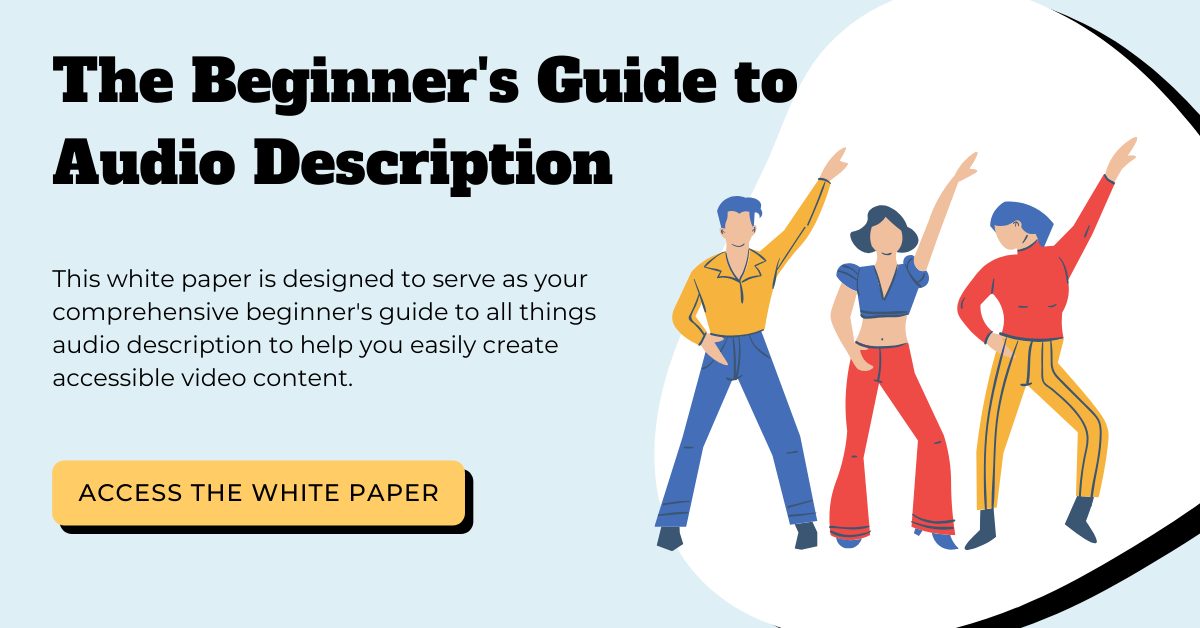What Is Audio Description?
Updated: August 23, 2024
Imagine trying to enjoy a TV show, movie, or live performance, but not being able to see it. It would be challenging to gain a complete understanding of what is happening. You would most likely miss crucial information that is expressed visually through gestures, character actions, or scenery, rather than through audio. There is an exorbitant amount of detail that can be conveyed in a single image.
That’s where audio description (AD) comes in.
Take a moment to imagine this description, almost as if you were reading it from a book–
Without any visual illustrations, this description paints a pretty vivid picture of a scene from the movie Frozen. Listen to the description yourself in the official movie trailer:
A Definition of Audio Description
What is audio description? For those with visual impairments, description is the key to revealing detailed information that sighted people consume without a thought.
Audio description (also referred to as “description” or “video description”) is defined as “the verbal depiction of key visual elements in media and live productions.” AD is meant to provide information on visual content that is considered essential to the comprehension of the program. In these cases, not providing AD would inhibit blind and visually impaired individuals from gaining a complete understanding of the given program.
The description of media involves the interspersion of AD snippets within the program’s original audio components, just like the example above. This is to allow the individual the benefit of the description, without sacrificing the information in the existing content.
How Do You Publish AD?
The World Wide Web Consortium (W3C) lists several sufficient techniques for adding description to audio-visual material. All of these methods are reliable ways to meet the WCAG Success Criterion.
Adding a second, user-selectable soundtrack with AD.
Most devices don’t have the capability of merging multiple soundtracks. This method accommodates for that by providing an option that allows users to replace the original soundtrack with a new version of the soundtrack which contains audio description. For those platforms that do allow two audio tracks to play simultaneously, a secondary audio track containing just the description is sufficient.

A White Paper for You
What should you know about audio description? Learn all you need to know in our Beginner’s Guide to Audio Description.
DownloadProviding a version of a movie with audio descriptions.
This approach adds the AD to synchronized media by utilizing a second version of the movie where the original soundtrack and additional AD are combined into a single track.
Providing a movie with extended audio descriptions.
This approach involves providing a second version of video content with extended AD. One of the main obstacles in creating traditional AD is that a vast amount of information needs to be provided in a very short amount of time (such as during pauses in the dialogue.) Typically a version of the movie with extended AD and a version without descriptions are available, or the AD can be turned on and off.
Using a static text alternative to describe a talking-head video.
This method is considered an alternative to audio descriptions, and is best used for media that doesn’t have important time-based information in the original video portion of the media. For example, this technique would be sufficient for “talking head” videos such as a press conference, where an individual is speaking in front of a static background and there are no important visual elements to describe.
Using a WebVTT description track.
HTML5 video allows for the use of a WebVTT description file. This file would be included as a element with the “description.” Screen readers should be able to read this file to provide description to users. However, this functionality has very limited support across video players.
How to Toggle Descriptions On/Off
There are several ways to enable audio descriptions, depending on your cable provider and device. Netflix has AD available for many of its programs and continues to increase its availability. Netflix users can enable AD the same way they would choose subtitles or captions by visiting their “How do I adjust subtitles, captions and alternate audio on my device?” page. For TV shows or movies that are not on Netflix, you may be able to turn AD on through a language button on the remote.
Just as captions and transcripts make video accessible for those who are Deaf or hard of hearing, audio description does the same for those who are blind or visually impaired. Both services fall under the same category of accessibility, with a shared overarching goal of making video equally accessible for all individuals.
__






